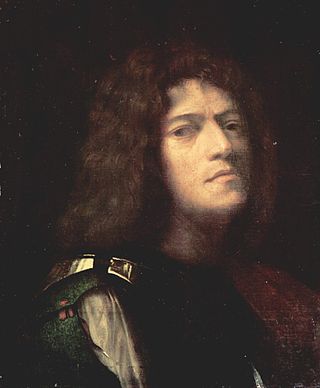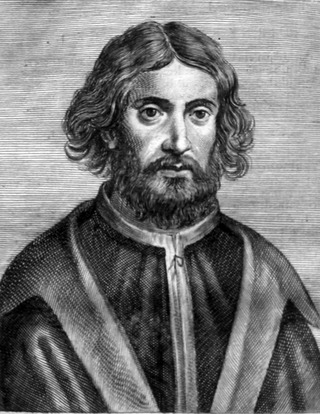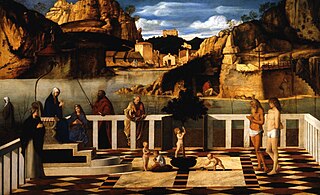
Fra Bartolomeo or Bartolommeo, also known as Bartolommeo di Pagholo, Bartolommeo di San Marco, Paolo di Jacopo del Fattorino, and his original nickname Baccio della Porta, was an Italian Renaissance painter of religious subjects. He spent all his career in Florence until his mid-forties, when he travelled to work in various cities, as far south as Rome. He trained with Cosimo Rosselli and in the 1490s fell under the influence of Savonarola, which led him to become a Dominican friar in 1500, renouncing painting for several years. Typically his paintings are of static groups of figures in subjects such as the Virgin and Child with Saints.

Giorgio Barbarelli da Castelfranco, known as Giorgione, was an Italian painter of the Venetian school during the High Renaissance, who died in his thirties. He is known for the elusive poetic quality of his work, though only about six surviving paintings are firmly attributed to him. The uncertainty surrounding the identity and meaning of his work has made Giorgione one of the most mysterious figures in European art.

Tiziano Vecellio, Latinized as Titianus, hence known in English as Titian, was an Italian Renaissance painter, the most important artist of Renaissance Venetian painting. He was born in Pieve di Cadore, near Belluno. During his lifetime he was often called da Cadore, 'from Cadore', taken from his native region.

Jacopo Bellini was one of the founders of the Renaissance style of painting in Venice and northern Italy. His sons Gentile and Giovanni Bellini, and his son-in-law Andrea Mantegna, were also famous painters.

Andrea Mantegna was an Italian Renaissance painter, a student of Roman archeology, and son-in-law of Jacopo Bellini.

Il Sodoma was the name given to the Italian Renaissance painter Giovanni Antonio Bazzi. Il Sodoma painted in a manner that superimposed the High Renaissance style of early 16th-century Rome onto the traditions of the provincial Sienese school; he spent the bulk of his professional life in Siena, with two periods in Rome.

Vittore Carpaccio (UK: /kɑːrˈpætʃ oʊ/, US: /-ˈpɑːtʃ-/, Italian: [vitˈtoːre karˈpattʃo]; was an Italian painter of the Venetian school who studied under Gentile Bellini. Carpaccio was largely influenced by the style of the early Italian Renaissance painter Antonello da Messina, as well as Early Netherlandish painting. Although often compared to his mentor Gentile Bellini, Vittore Carpaccio's command of perspective, precise attention to architectural detail, themes of death, and use of bold color differentiated him from other Italian Renaissance artists. Many of his works display the religious themes and cross-cultural elements of art at the time; his portrayal of Saint Augustine in His Study from 1502, reflects the popularity of collecting "exotic" and highly desired objects from different cultures.

Baldassare Tommaso Peruzzi was an Italian architect and painter, born in a small town near Siena and died in Rome. He worked for many years with Bramante, Raphael, and later Sangallo during the erection of the new St. Peter's. He returned to his native Siena after the Sack of Rome (1527) where he was employed as architect to the Republic. For the Sienese he built new fortifications for the city and designed a remarkable dam on the Bruna River near Giuncarico. He seems to have moved back to Rome permanently by 1535. He died there the following year and was buried in the Rotunda of the Pantheon, near Raphael.

Giuseppe Maria Crespi, nicknamed Lo Spagnuolo, was an Italian late Baroque painter of the Bolognese School. His eclectic output includes religious paintings and portraits, but he is now most famous for his genre paintings.

Portrait of Elisabetta Gonzaga is an oil on wood painting attributed to the Italian Renaissance artist Raphael, completed c. 1504–1505, and today housed in the Uffizi Gallery, Florence.

The Test of Fire of Moses is a painting by the Italian Renaissance master Giorgione created c. 1502–1505. It is housed in the Galleria degli Uffizi of Florence.

Palma Vecchio, born Jacopo Palma, also known as Jacopo Negretti, was a Venetian painter of the Italian High Renaissance. He is called Palma Vecchio in English and Palma il Vecchio in Italian to distinguish him from Palma il Giovane, his great-nephew, who was also a painter.

The Four Allegories is a series of four small panel paintings in the Gallerie dell'Accademia, Venice, Italy by the Italian Renaissance master Giovanni Bellini, whose date has been variously argued as different points in the range 1490–1504. They all measure 34 (Perseverance) or 32 × 22 cm in size.

The Holy Allegory is a painting by the Italian Renaissance master Giovanni Bellini, dating from c. 1490 to 1500. It is in the Uffizi gallery in Florence, Italy.

The Madonna and Child Enthroned with Saints John the Baptist and Sebastian is a painting by the Italian Renaissance artist Pietro Perugino, executed in 1493 and housed in the Uffizi Gallery, Florence.

St. Jerome in the Desert or St. Jerome Reading in the Desert is a 1480 oil-on-panel painting by the Italian Renaissance master Giovanni Bellini, now in the Uffizi Gallery in Florence as part of the Contini Bonacossi collection, giving it its alternative title of The Contini Bonacossi St. Jerome.

Lamentation over the Dead Christ is a c. 1500 tempera-on-panel painting by the Italian Renaissance master Giovanni Bellini kept at the Uffizi Gallery in Florence.

Madonna Adoring the Sleeping Christ Child is a c.1475 tempera-on-panel painting by the Italian Renaissance artist Giovanni Bellini, measuring 77 cm by 56 cm. It forms part of the Contini Bonacossi Collection within the Uffizi Gallery in Florence.

Portrait of a Young Senator is an oil-on-panel painting by the Italian Renaissance master Giovanni Bellini, dating to 1490–1500 and now in the Uffizi Gallery in Florence.

Madonna and Child is an oil-on-panel painting created in 1504 by the Italian Renaissance painter Cima da Conegliano, now in the Museo nazionale atestino in Este. It is the most important pictorial work in the museum, which is mainly dedicated to archeology.




















